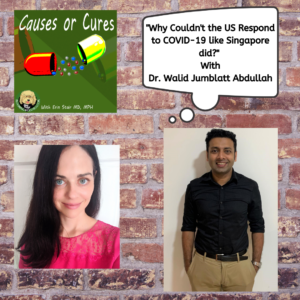Singapore’s Response to COVID-19

There has been a lot of praise for Singapore’s Response to COVID-19, especially in the beginning of the pandemic. There has also been a lot of criticism over how the US handled the pandemic, which leads to the question: Why did Singapore’s reponse work well, compared to the US’s response? What did they do differently? Why is their mortality rate so much lower than ours?
To help unearth answers to these questions, Singapore’s Dr. Abdullah joined me on my Causes or Cures podcast to discuss. Dr. Abdullah is a professor of social sciences and researcher at the Nanyang Technological University in Singapore. He recently published a critical assessment of Singapore’s response to COVID-19. His areas of research include political systems and elections, state-religion relations, political Islam and Southeast Asia politics.
In the podcast, we discuss the specifics around Singapore’s response to COVID-19. We talk about when lockdowns went into effect, their testing strategy and how it changed over time, when they issued mask mandates, and how they ensure that the population follows the mandates. We also talk about Singapore’s political structure, which is much different than the US, and a huge reason that government-issued orders are more easily followed in Singapore than the US. And we discuss the differences between the populations in Singapore and the US: one seems to have a lot of trust in their government, and one doesn’t. Why does all that matter? Because a public health intervention is only as good as the population’s willingness to comply with it. No matter how sound a public health intervention may seem, if the population won’t have it, it won’t work. It’s the difference of something looking good on paper but blowing up in your face in real life.
We also talk about the difference in Singapore’s obesity rate compared to ours, since obesity is linked to more severe COVID-19 infections and mortality rates. What is Singapore’s government doing to keep the obesity rates down? What is our government doing? What we do know, and what is tragic, is that 50% of the adult US population is predicted to be obese by 2030, and obesity makes almost every health condition worse. That is more than a little concerning.
This is a great podcast for anyone interested in how a public health intervention that might work well with one population will not work with another. It’s really a story about understanding your target population and needing to tweak interventions and health communications to connect with your target population. Public Health is a population-level science. It’s population-level interventions. If you can’t convince your population to go along with your intervention, well, what good is it?
Click here to listen!
Other podcasts to listen to:
Early At-Home Treatment for COVID-19 Can Save Lives: So Why aren’t we talking about it more?
Why Wellness is a Luxury Brand
